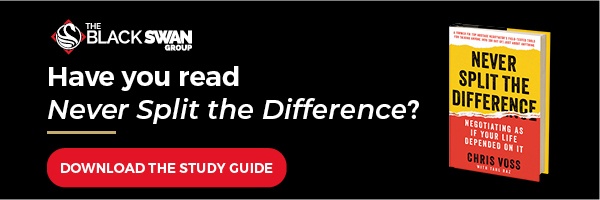Does yes really always mean yes?
Absolutely not.
When we say yes, we’re committing to something. And immediately after we’ve committed, we begin worrying about what we’ve just signed up for.
This means, at best, every yes is a conditional yes. And oftentimes, it’s even worse: a counterfeit yes that’s uttered simply to get the other side to shut up.
Would it be ridiculous to find out that getting the other side to say no is actually what you should be gunning for when you sit down at the table?
The Beauty of Saying No
Whereas yes is a commitment, no is protection. There isn’t any shaky ground here, either. When we say no, we mean it. No is always no.
Why not use these three ways to make no work for you?
- To break an impasse
- To get someone’s attention, especially if they’ve stopped responding to you
- To help someone think clearly
Getting someone to say no is easy. It’s one of the best communication skills you can possess. Just flip your yes-oriented questions into no-oriented questions. Instead of asking the maître d’, Is it OK if we sit in the reserved section of the restaurant? ask them, Would it be horrible if we sat there?
Pretty much every yes-oriented question you ask can be flipped around by adding phrases like these to your statement:
- Have you given up on ... ?
- Is it ridiculous ... ?
- Would it be horrible ... ?
- Is it a bad idea ... ?
Have You Given Up on This Project?
When you ask the other side whether they’ve given up on the project—or whatever the issue at hand might be—it triggers the safety of no. At the same time, it also taps into prospect theory, the Nobel Prize-winning concept that loss aversion drives action more than the desire for gain. Did you know people are twice as likely to take an action to avoid a loss than they are to accomplish a gain? Use this knowledge to your advantage.
Our clients swear by this question. In fact, it’s one of the top email subject lines that produces results. There’s one caveat here: Make sure you’re ready for a quick answer and are prepared to deliver a “That’s Right” Summary ™ before you move any further.
Would It Be Ridiculous for You to Come Speak at the Negotiation Course I Teach at USC?
I asked Jack Welch, the legendary CEO of General Electric (rest in peace) this question when I approached him cold at a book signing once. He stopped dead in his tracks and gave me his personal assistant’s contact information so we could try to make our calendars sync. Unfortunately, the timing didn’t work. But how many people can get digits like that?
Think about how many questions someone like Jack Welch is asked every day, and how almost all of them are yes-oriented questions: Would you sign this autograph? Being able to say no and feel protected makes us more open to other ideas.
I also got Shark Tank’s Robert Herjavec to buy tickets to The Black Swan Group’s one-day negotiation training master class using this same kind of question.
Would It Be Horrible If We Sat in This Section?
One day, a couple of colleagues and I had just come out of a conference. We were a bit thirsty, so we headed into a restaurant in search of a happy hour cocktail—just one. There was a problem: There weren’t any seats at the bar. But there were seats in a roped-off section of the restaurant.
So, I asked the waitress the above question, and she told us that it would be perfectly fine to sit there as long as we were out by 6. We were, and I left her a great tip.
Is It a Bad Idea to Cut a Deal?
One of our clients used this during a break in a recent training session to cut a deal back home. She left the room during the break and used it to suggest an alternative solution that her colleague had been resisting.
His reply was straightforward: No, it wouldn’t be. And the deal was made.
The Power of No-Oriented Questions
I actually ask everyone who works with me to only use no-oriented questions™ with me late in the day. Science tells us we’re only capable of making a certain amount of decisions every day, and by the end of the day, our brains start to wear out. This is why people like Mark Zuckerberg and Steve Jobs have been notorious for wearing the same thing every day. They’re not interested in burning up mental decision power on what shirt to wear when the decisions they make every day are worth millions of dollars.
When someone asks me a Calibrated Question™ that begins with what or how and I’m fatigued, I likely won’t answer until the next day. If they give me a Is this a bad idea? type of question, I actually find myself quickly focusing—and even getting a little bit of energy—and being able to answer.
Practice makes perfect. Use these communication skills in low-stakes scenarios—like the next time you’re checking out with a clerk or on the phone with your cable company. (Think: Would it be ridiculous for you to give a loyal customer like me the same deal you give new subscribers?)
Is it a bad idea to leverage the natural human inclination to say no to get things done?
Well, what do you think?
This blog was originally published on 11/14/2016 and updated on 7/23/2020.


